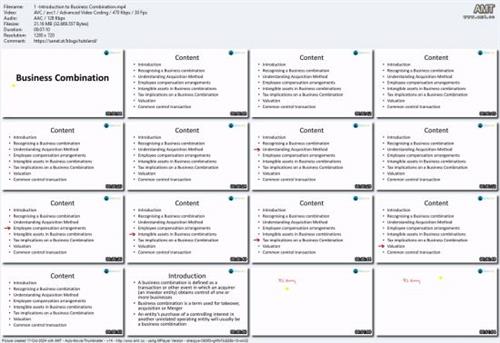
Published 10/2024
MP4 | Video: h264, 1280x720 | Audio: AAC, 44.1 KHz, 2 Ch
Language: English | Duration: 6h 40m | Size: 2.32 GB
Master the art of business combinations, acquisitions, and valuations, and gain the expertise for decision-making.
What you'll learn
Understanding Business Combinations: Students will learn what qualifies as a business combination, including recognizing transactions.
Acquisition Methods: The course will provide in-depth insights into the application of the acquisition method.
Accounting for Goodwill and Intangible Assets: Students will understand how to recognize and measure goodwill and intangible assets acquired.
Consideration in Business Combinations: The course covers how to determine and account for consideration in mergers and acquisitions.
Tax Implications: Students will explore the income tax implications of business combinations and how these affect financial statements.
Valuation Techniques: The course will focus on various valuation techniques used in business combinations, including valuation of intangible assets.
Reverse Acquisitions and Asset Acquisitions: Students will learn the specifics of reverse acquisitions and how asset acquisitions differ from traditional ways.
Practical Examples and Case Studies: Throughout the course, students will work through real-world examples and case studies.
By the end of the course, students will have a robust understanding of how to account for business combinations
Requirements
Basic Accounting Knowledge: A foundational understanding of accounting principles, such as the preparation of financial statements, balance sheets, and income statements, is essential. Familiarity with the accounting equation and financial reporting standards will be beneficial.
Understanding of Financial Statements: Students should have a grasp of the different types of financial statements (e.g., income statement, balance sheet, and cash flow statement) and how they are used in business analysis.
Introductory Knowledge of Business: A general understanding of business operations, organizational structures, and basic corporate finance concepts will help students relate to the practical applications of business combinations.
Familiarity with Financial Reporting Standards: Basic knowledge of accounting standards such as GAAP (Generally Accepted Accounting Principles) or IFRS (International Financial Reporting Standards) will help in understanding the regulatory framework under which business combinations are recorded.
Mathematical Skills: Some basic math skills, especially in relation to percentages and financial calculations, will be useful when working through valuation techniques and accounting for consideration in business combinations.
Description
This course offers an in-depth exploration of business combinations, focusing on various types of transactions, the recognition and application of acquisition methods, and the accounting treatment of business combinations in accordance with global accounting standards. Covering concepts from business combinations to reverse acquisitions, intangible assets, and tax implications, this course equips learners with the tools to navigate complex acquisition processes. With practical examples and case studies, students will gain the knowledge necessary to make informed decisions in business acquisitions, mergers, and consolidations.Section 1: IntroductionIn this section, students are introduced to the concept of business combinations. The first lecture defines business combinations and sets the stage for understanding their strategic importance. Students will get a foundational grasp of how business combinations fit into broader corporate strategies.Section 2: Transactions that are Business CombinationsThis section delves into the types of transactions that qualify as business combinations, highlighting how to recognize such transactions. The section also covers distinctions between business combinations and asset acquisitions, followed by practical examples to demonstrate real-world applications.Section 3: Identifying Business CombinationsStudents will learn to identify business combinations, including the complexities involved in mutual enterprise combinations and exchanges of assets between companies. This section will also explore exceptions to business combinations and the concept of common control transactions.Section 4: Applying the Acquisition MethodThe focus here shifts to the application of the acquisition method in business combinations. Key topics include how to identify the acquirer, the role of new companies as acquirers, and how to determine the acquisition date. Real-life examples help solidify the understanding of these concepts, including defensive intangible assets and inventory.Section 5: ConsiderationThis section explores the various types of consideration in business combinations and their accounting treatment. Topics include determining the classification of consideration, approaches to business combination settlement, and examples of employee compensation and acquisition costs. Through detailed examples, learners will grasp how consideration impacts financial statements.Section 6: Reverse AcquisitionStudents will study reverse acquisitions in detail, including their accounting implications. The concept of Variable Interest Entities (VIE) and Special Purpose Entities (SPE) will also be introduced, helping students understand complex acquisition scenarios that defy traditional acquisition structures.Section 7: Intangible Assets Acquired in a Business CombinationThis section focuses on how intangible assets acquired during a business combination are identified and valued. Topics such as the contractual-legal criterion, separability criterion, and the identification of customer-related intangible assets will be thoroughly discussed.Section 8: Income Tax Implications in Business CombinationsUnderstanding the tax implications of business combinations is crucial for strategic decision-making. This section covers the tax considerations when combining businesses and how to account for partial acquisitions. Students will also learn how to determine financial statements' tax impacts and work through examples.Section 9: Valuation and Common Control TransactionsThis section dives into the complexities of valuation techniques used in business combinations. Students will also explore common control transactions, discussing how they differ from other business combinations and their accounting treatment.Section 10: Asset AcquisitionIn the final section, students will focus on asset acquisitions-when they occur and how they are accounted for. Detailed examples and case studies will show how asset acquisitions differ from business combinations and how to assess the value of assets in these transactions.Conclusion:By the end of this course, students will have gained comprehensive knowledge of the various types of business combinations, the intricacies of applying the acquisition method, and the impact of tax, valuation, and intangible assets on these transactions. With hands-on examples and real-world applications, students will be well-equipped to manage or advise on business combinations in a practical business setting.
Who this course is for
Accounting and Finance Professionals: Individuals working in accounting, finance, or auditing who want to deepen their understanding of business combinations, mergers, acquisitions, and related accounting processes.
Corporate Finance and Strategy Professionals: Business managers, corporate strategists, and consultants involved in M&A (Mergers and Acquisitions) processes, or who need to understand how to account for and structure business combinations.
Students in Finance and Accounting: University students or recent graduates pursuing degrees or certifications in finance, accounting, or business administration who seek practical knowledge and real-world application in business combinations and acquisitions.
Aspiring CFOs and Financial Analysts: Those preparing for senior roles in finance, such as Chief Financial Officer (CFO) or financial analysts, who will be involved in business transactions, corporate restructuring, or acquisitions.
Investment Bankers and M&A Advisors: Professionals working in investment banking, mergers, and acquisitions advisory firms who need a strong grasp of the financial and accounting implications of business combinations.
Legal Professionals in Corporate Law: Lawyers or legal consultants specializing in corporate law or M&A transactions who need to understand the accounting aspects of business combinations to better advise clients.
Homepage:
- Kod: Zaznacz wszystko
https://www.udemy.com/course/business-combinations-and-acquisitions-an-accounting-guide/
Screenshots

Say "Thank You"
rapidgator.net:
https://rapidgator.net/file/f023e772eedac2d3e14005a1f943aecb/rzsoy.Business.Combinations.and.Acquisitions.An.Accounting.Guide.part1.rar.html
https://rapidgator.net/file/97e211a55a62c3b0c3a5ccf1fb5f748a/rzsoy.Business.Combinations.and.Acquisitions.An.Accounting.Guide.part2.rar.html
https://rapidgator.net/file/5c601f9954c6fbd3725e51ec2e8d5e6d/rzsoy.Business.Combinations.and.Acquisitions.An.Accounting.Guide.part3.rar.html
ddownload.com:
https://ddownload.com/mcmi45bsit5v/rzsoy.Business.Combinations.and.Acquisitions.An.Accounting.Guide.part1.rar
https://ddownload.com/jqu6kbh4h6a7/rzsoy.Business.Combinations.and.Acquisitions.An.Accounting.Guide.part2.rar
https://ddownload.com/yjjh0k2l8qsr/rzsoy.Business.Combinations.and.Acquisitions.An.Accounting.Guide.part3.rar

 News
News